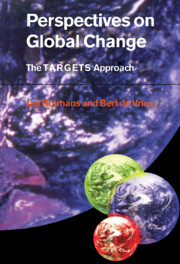Book contents
- Frontmatter
- Contents
- Foreword
- Preface
- 1 Global change and sustainable development
- Part One The TARGETS model
- Part Two Exploring images of the future
- 11 Towards integrated assessment of global change
- 12 Population and health in perspective
- 13 Energy systems in transition
- 14 Water in crisis?
- 15 Food for the future
- 16 Human disturbance of the global biogeochemical cycles
- 17 The larger picture: utopian futures
- 18 Uncertainty and risk: dystopian futures
- 19 Global change: fresh insights, no simple answers
- References
- Acronyms, units and chemical symbols
- Index
11 - Towards integrated assessment of global change
from Part Two - Exploring images of the future
Published online by Cambridge University Press: 06 July 2010
- Frontmatter
- Contents
- Foreword
- Preface
- 1 Global change and sustainable development
- Part One The TARGETS model
- Part Two Exploring images of the future
- 11 Towards integrated assessment of global change
- 12 Population and health in perspective
- 13 Energy systems in transition
- 14 Water in crisis?
- 15 Food for the future
- 16 Human disturbance of the global biogeochemical cycles
- 17 The larger picture: utopian futures
- 18 Uncertainty and risk: dystopian futures
- 19 Global change: fresh insights, no simple answers
- References
- Acronyms, units and chemical symbols
- Index
Summary
This chapter introduces Part Two of the book, which reports on experiments with submodels of TARGETS 1.0 carried out to assess a number of global change controversies. The experiments include a range of utopias and dystopias to discover whether the problem at the core of each controversy is likely to occur, and if so, under what conditions. The hierarchist utopia, which reflects the assumptions behind many reputable scenario studies, is used as a reference case to explore issues such as population growth, demand for food, water and energy, the environmental consequences of these pressures, and a range of societal responses. The results of integrated experiments with the TARGETS 1.0 model are presented at the end of this part of the book.
Introduction
Part One of this book described tools for performing integrated assessments of global change. The aim of Part Two is to gain insights by using these tools, both withthe separate submodels and with the integrated TARGETS 1.0 model. The main goal of TARGETS is to put possible developments within the subsystems of the world into perspective in an integrated way. In this way we hope to provide a context for discussing global change and sustainable development. The quantitative modelling framework is used to support the qualitative framing of important issues. Though they are partial and limited in scope, the resulting images of possible global futures enable us to localise areas of tension and directions for sustainable development strategies.
- Type
- Chapter
- Information
- Perspectives on Global ChangeThe TARGETS Approach, pp. 223 - 238Publisher: Cambridge University PressPrint publication year: 1997

